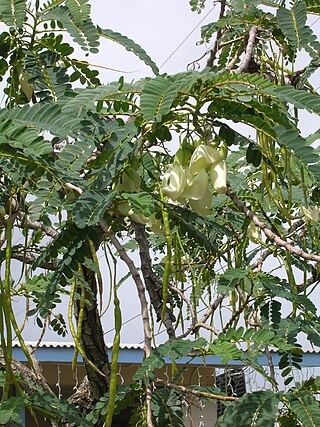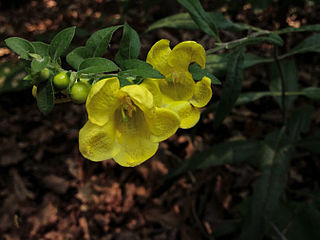
Digitalis is a genus of about 20 species of herbaceous perennial plants, shrubs, and biennials, commonly called foxgloves.

Digitalis purpurea, the foxglove or common foxglove, is a toxic species of flowering plant in the plantain family Plantaginaceae, native to and widespread throughout most of temperate Europe. It has also naturalised in parts of North America and some other temperate regions. The plant is a popular garden subject, with many cultivars available. It is the original source of the heart medicine digoxin. This biennial plant grows as a rosette of leaves in the first year after sowing, before flowering and then dying in the second year. It generally produces enough seeds, however, so that new plants will continue to grow in a garden setting.

Sesbania grandiflora, commonly known as vegetable hummingbird, katurai, agati, or West Indian pea, is a small leguminous tree native to Maritime Southeast Asia and Northern Australia. It has edible flowers and leaves commonly eaten in Southeast Asia and South Asia.
False foxglove may refer to:

Digitalis grandiflora, the yellow foxglove, big-flowered foxglove, or large yellow foxglove, is a species of flowering plant in the genus Digitalis, family Plantaginaceae. It is native to southern Europe and Asia. In mountains it grows on warm, bushy slopes or areas left after logging. The Latin specific epithet grandiflora means “large flowered”.

Agalinis is a genus of about 70 species in North, Central, and South America that until recently was aligned with members of the family Scrophulariaceae. As a result of numerous molecular phylogenetic studies based on various chloroplast DNA (cpDNA) loci, it was shown to be more closely related to members of the Orobanchaceae. Agalinis species are hemiparasitic, which is a character that in part describes the Orobanchaceae.

Agalinis aspera, the rough agalinis, rough false foxglove, or tall false foxglove, is a non-poisonous plant of the genus Agalinis, habitating in the dry prairies. It can grow to be about eight to twenty-four inches tall. When the flowers bloom, the colors vary between purple and pink.

Digitalis × fulva, the strawberry foxglove, is a hybrid species of flowering plant within the family Plantaginaceae. It is a naturally occurring fertile hybrid between the species Digitalis grandiflora and Digitalis purpurea. The species is widely marketed in the UK under the common name strawberry foxglove or its taxonomic synonym Digitalis × mertonensis. The species has been used to produce various cultivars and has gained the Royal Horticultural Society's Award of Garden Merit.

Aureolaria, with the common name false foxgloves, is a genus of 8 species, native to North America.

Aureolaria virginica, the downy yellow false foxglove or downy oak leach, is a perennial forb native to the eastern United States and Canada, which produces yellow flowers in summer.

Agalinis tenuifolia, known by the common names common gerardia, slender false foxglove or common false foxglove, is an annual forb native to the eastern and southwestern United States, and Canada, which produces purple flowers in late summer or early fall.

Aureolaria patula, commonly known as spreading yellow false foxglove or Cumberland oak-leach, is a species of plant in the family Orobanchaceae. It is native to the upper Southeastern United States, where it is found in Alabama, Georgia, Kentucky, and Tennessee. Due to its limited geographic range, this species in considered vulnerable, and is listed as rare in every state it is found. It is often found in populations consisting of only a few plants. Its habitat is rich alluvial forests and limestone slopes along major rivers.

Aureolaria pedicularia, the fernleaf yellow false foxglove, fern-leaved false foxglove, or fernleaf false foxglove, is a parasitic plant of the family Orobanchaceae. Aureolaria pedicularia is native to parts of the eastern US, the Midwest, and adjacent Canada. This plant is known for its distinct leaf shape and overall plant size. The common names for Aureolaria pedicularia come from its fern-like leaves.

Aureolaria levigata, commonly known as entireleaf yellow false foxglove or Appalachian oak-leech, is a species of flowering plant in the family Orobanchaceae. It is native to much of the Appalachian Mountains and surrounding areas in the eastern United States. It is also found in a disjunct population in southwestern Mississippi.

Agalinis heterophylla is a species of flowering plant in the family Orobanchaceae known as prairie false foxglove. It is found in northern Mexico (Tamaulipas) and the southeastern and central United States.

Aureolaria pectinata, commonly called combleaf yellow false foxglove, false foxglove, and comb-leaf oakleach, is a species of plant in the broomrape family that is native to the southeastern United States.
Kaučers Protected Landscape is located in Rušona Parish, Preiļi Municipality in the Latgale region of Latvia. The area is named after Lake Kaučers, which is located in the center of the protected area. There are six other lakes in the protected area: Lake Baiba, Esereits, Limins, Meirauka, Salmejs and Lake Stupon. The state highway V742 passes through the northern part of the territory. Next to it is Gaiļmuiža. This is an Natura 2000 site.

Aureolaria flava, commonly called smooth yellow false foxglove, is a species of plant in the broomrape family that is native to the eastern United States.














